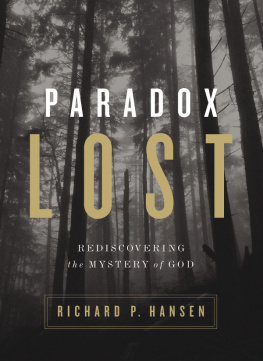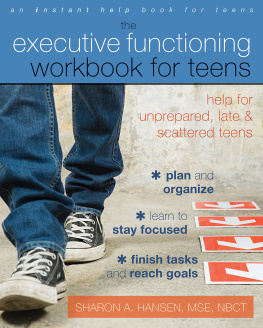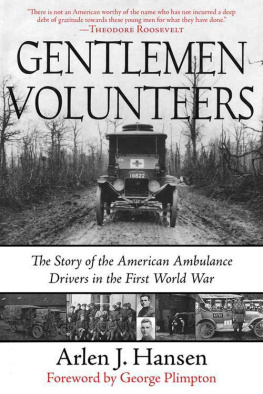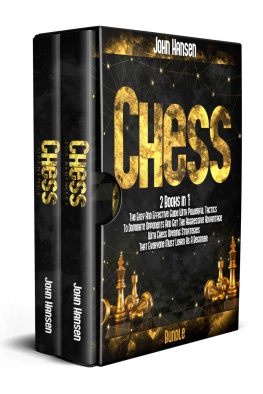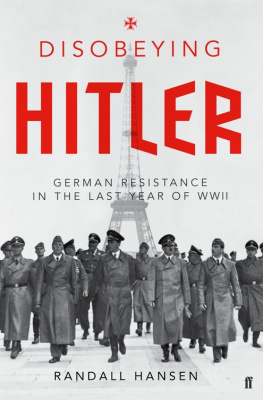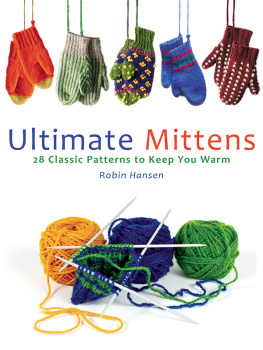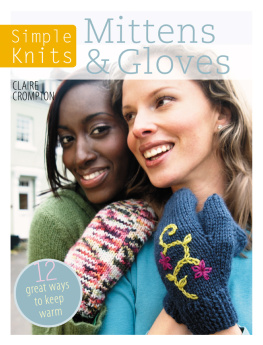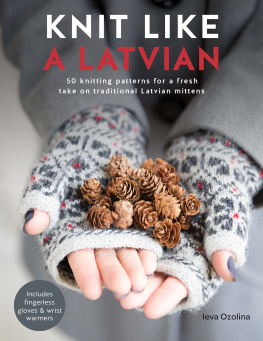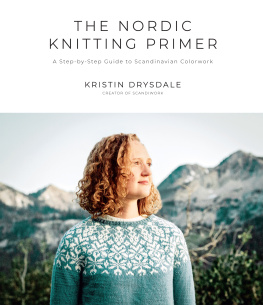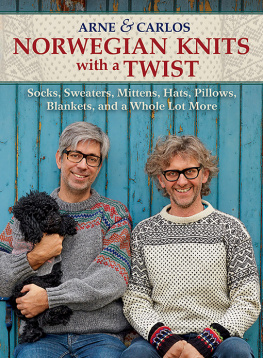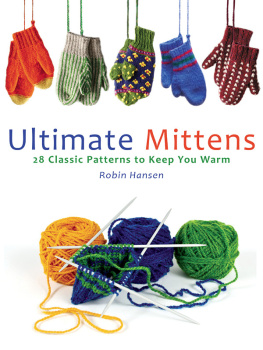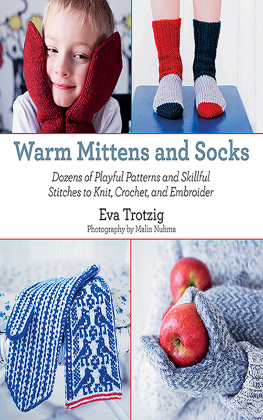About the Author
Since Fox & Geese & Fences was published more than twenty years ago, Robin Orm Hansens books have been recognized as authoritative sources for traditional mittens, knitted and otherwise. (Americas favorite knitting writer, Elizabeth Zimmermann, said that Fox & Geese & Fences was just what Americas knitters need!) For the past two decades, Robin has continued searching out traditional knitters New England, the Canadian Maritimes, and Scandinavia, collecting nearly extinct family patterns for practical handknit mittens. She tests the patterns, clarifying or adding to the directions as needed, and makes them available to todays knitters in an easy-to-follow format.
Robin has also written articles on traditional knitting for Interweave Knits, Knitters Magazine, Vogue Knitting, and Knitting Now and has taught workshops from Texas to Surrey, England. Her original article on fishermens mittens, New England Boiled Mittens, was selected for The Best of Yankee Magazine, a collec tion of articles spanning fifty years. She earned her doctorate in folklore and folk life from Boston University, based on her knitting research in Canada and Maine.
In recent years, Robin has made several trips to the remote Faroe Islands, north of Scotland, collecting traditional double-knitting patterns used on sweaters. Shes found that many Faroese patterns are also used by North American knitterspossibly because of shared fishing grounds and trade routes.
Robin lives with her husband, one son, and twenty-five sheep on a small farm in West Bath, Maine.
Acknowledgments
Any collection of traditional processes must be the work of more than one person. It takes generations of craftspersons to carry a tradition into the present. It takes people like me and Down East Books to see the need to present the process to the wider public in a book, and it takes people hungry for roots to sink deeper into a native soil to read the book and make the mittens. Most of all, it takes the willingness of living tradition-bearers to share what amounts to privileged family craft techniques and lore with thousands of people they will never see or know.
To thank the knitters of the past and present for maintaining traditional knitting designs is superfluous, as their reward is in the pleasure of knitting and the love of those who wear their creations.
I thank those in the present generation who shared family knitting traditions: Ruth Claxton, formerly of Harpswell, Maine, for local information on Compass Mittens and Fox and Geese Mittens; Harriet Pardy Martin of Happy Valley, Labrador, for the basic instructions used for all the Newfoundland mittens; and Phyllis Montague of Northwest River, Labrador, for sharing her mothers Big Waves pattern; Albert Miller of Turner, Maine, for Mittens Hooked on a Dowel; Edna Mower of Merrimack, New Hampshire, and Beulah Moore of Kingfield, Maine, for Double-Rolled Mittens; Margaret Richard and Annie Pettipas of Charlos Cove, Nova Scotia, for Fleur-de-lis Mittens; Erin Pender for helping me to figure out Mittens with Shag on the Inside. These are only those whose family traditions contributed to this book. There are too many more of different traditions to mention.
In Maine, I thank Laura Ridgewell of West Point who gave me the idea for publishing a book of traditional Maine mittens when she asked me to find her a fishermens wet mitten pattern. Jackie Trask, Diane Calder, and Elizabeth Bergh, all of Chebeague Island, Marge Creaser of Boothbay, and Mary A. Chase of South Brooksville provided much of the information on wet mittens. The instructions were written by Elizabeth Bergh, based on a pair of mittens knit by Jackie Trasks late grandmother, Minnie Doughty.
In Labrador, Judith McGrath, a crafts researcher for Them Days magazine, and Peggy Lough, both of Happy Valley, helped me with instructions for Fleece-Stuffed Mittens. Laura Jackson, also formerly of Happy Valley, showed me more Labrador mitts and introduced me to local knitters. Thank you!
In Atlantic Canada, I thank the women who shared with Janetta Dexter the patterns she has passed on in this book, particularly Mrs. Viette Cruikshank of Liscomb, Nova Scotia, for the Mattie Owl story and pattern (Compass Mittens), and Mrs. Murdock Hollingsworth of Truro, Nova Scotia, for information about Flying Geese Gloves.
I also thank the Nova Scotia Museum for letting me use the Flying Geese and Maplewood patterns that appeared in Janetta Dexters book, Traditional Nova Scotian Double-Knitting Patterns (Halifax, 1985); Them Days magazine and Doris Saunders of Happy Valley, Labrador, for permission to reprint the interview and photos of her mother, Harriet Pardy Martin; the Maine State Museum for permission to print their photos and information on Double-Rolled Mittens.
Joan Waldron of the Nova Scotia Museum became a good friend. She put me in touch with knitting traditions in her province and introduced me to Janetta Dexter. Jane Nylander, formerly textile curator at Old Sturbridge Village, and Jane Radcliffe, formerly textile curator at the Maine State Museum, both helped by giving me access to their collections and expanding my general knowledge of traditional mitten knitting in their areas. Many thanks!
Thanks to the late Elizabeth Zimmermann and her daughter, Meg Swanson, the doyennes of American knitting design, for advice on publication, for contacts, for providing many books on British, Scandinavian, and German knittingand most of all, for saying nice things about my books in the knitting world.
Thanks to Professor Anthony Barrand of the University Professors Program at Boston University, for putting up with my slightly bizarre field of study, for teaching me better ways of documenting interviews and new (to me) methods of observation, and for general encouragement. Thanks to the University Professors Program for taking me in and allowing me to deepen my study of traditional handcraft processes.
I would also like to thank Nora Johnson, formerly of Five Islands, Maine, my mentor and best friend in traditional knitting, who was the first traditional knitter willing to talk to me about Maine double-knit patterns. She taught me my first three patterns and commented on and reviewed all the mittens I found in various corners of New England and Canada. As a seasoned knitter, she checked some patterns for readability. Her insistence on high quality workmanship and technique in mitten knitting continues to guide my eyes and hands. Nora died at age 97 in March 2004. I will miss her more than I can say.
I would like to thank my family for their patience, particularly my daughter, Hanne Orm Tierney of Palmyra, Maine, who produced many of the sample mittens while testing the directions for accuracy, my daughter-in-law Michele Orm Hansen of Troy, Maine, and my niece Adrienne DOlimpio of Lyndonville, Vermont, for knitting samples and trial mittens for this book. My husband, Erik, a naval architect, helped me devise formulas for the proportions of mittens and caps, and patiently checked my math and the metric conversions. He has also been a pleasant companion and driver on mitten and woolly tours of the Maritime Provinceswhile I knit in the passenger seat!
I thank knit-technical editor Dorothy Ratigan. Her earnest work and insistence on a set format for the directions may make these the most complete and correct directions I have ever written. I do hope nothings left outor anything unnecessary is added!
Thanks also to Megan Richardson, summer intern at Down East Books, who added the metric conversions to make this book accessible for knitters who think in grams and centimeters. Down East Books editor Karin Womer demonstrated her patience in waiting for Dot and me to get the directions and the photos in order. Thanks, Karin! They are now finished.



